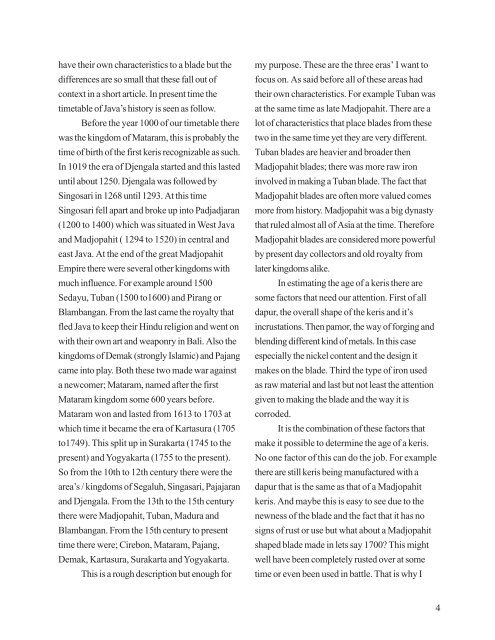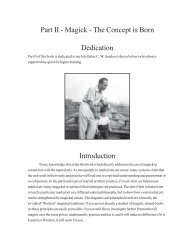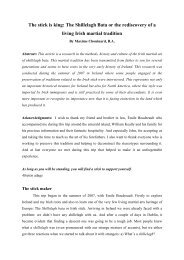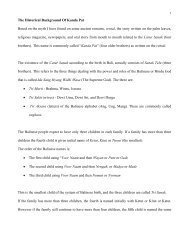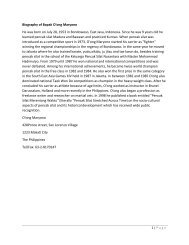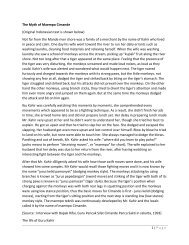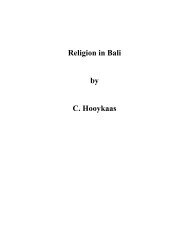Tenaga Dalam - Pukulan Cimande Pusaka
Tenaga Dalam - Pukulan Cimande Pusaka
Tenaga Dalam - Pukulan Cimande Pusaka
You also want an ePaper? Increase the reach of your titles
YUMPU automatically turns print PDFs into web optimized ePapers that Google loves.
have their own characteristics to a blade but the<br />
differences are so small that these fall out of<br />
context in a short article. In present time the<br />
timetable of Java’s history is seen as follow.<br />
Before the year 1000 of our timetable there<br />
was the kingdom of Mataram, this is probably the<br />
time of birth of the first keris recognizable as such.<br />
In 1019 the era of Djengala started and this lasted<br />
until about 1250. Djengala was followed by<br />
Singosari in 1268 until 1293. At this time<br />
Singosari fell apart and broke up into Padjadjaran<br />
(1200 to 1400) which was situated in West Java<br />
and Madjopahit ( 1294 to 1520) in central and<br />
east Java. At the end of the great Madjopahit<br />
Empire there were several other kingdoms with<br />
much influence. For example around 1500<br />
Sedayu, Tuban (1500 to1600) and Pirang or<br />
Blambangan. From the last came the royalty that<br />
fled Java to keep their Hindu religion and went on<br />
with their own art and weaponry in Bali. Also the<br />
kingdoms of Demak (strongly Islamic) and Pajang<br />
came into play. Both these two made war against<br />
a newcomer; Mataram, named after the first<br />
Mataram kingdom some 600 years before.<br />
Mataram won and lasted from 1613 to 1703 at<br />
which time it became the era of Kartasura (1705<br />
to1749). This split up in Surakarta (1745 to the<br />
present) and Yogyakarta (1755 to the present).<br />
So from the 10th to 12th century there were the<br />
area’s / kingdoms of Segaluh, Singasari, Pajajaran<br />
and Djengala. From the 13th to the 15th century<br />
there were Madjopahit, Tuban, Madura and<br />
Blambangan. From the 15th century to present<br />
time there were; Cirebon, Mataram, Pajang,<br />
Demak, Kartasura, Surakarta and Yogyakarta.<br />
This is a rough description but enough for<br />
my purpose. These are the three eras’ I want to<br />
focus on. As said before all of these areas had<br />
their own characteristics. For example Tuban was<br />
at the same time as late Madjopahit. There are a<br />
lot of characteristics that place blades from these<br />
two in the same time yet they are very different.<br />
Tuban blades are heavier and broader then<br />
Madjopahit blades; there was more raw iron<br />
involved in making a Tuban blade. The fact that<br />
Madjopahit blades are often more valued comes<br />
more from history. Madjopahit was a big dynasty<br />
that ruled almost all of Asia at the time. Therefore<br />
Madjopahit blades are considered more powerful<br />
by present day collectors and old royalty from<br />
later kingdoms alike.<br />
In estimating the age of a keris there are<br />
some factors that need our attention. First of all<br />
dapur, the overall shape of the keris and it’s<br />
incrustations. Then pamor, the way of forging and<br />
blending different kind of metals. In this case<br />
especially the nickel content and the design it<br />
makes on the blade. Third the type of iron used<br />
as raw material and last but not least the attention<br />
given to making the blade and the way it is<br />
corroded.<br />
It is the combination of these factors that<br />
make it possible to determine the age of a keris.<br />
No one factor of this can do the job. For example<br />
there are still keris being manufactured with a<br />
dapur that is the same as that of a Madjopahit<br />
keris. And maybe this is easy to see due to the<br />
newness of the blade and the fact that it has no<br />
signs of rust or use but what about a Madjopahit<br />
shaped blade made in lets say 1700? This might<br />
well have been completely rusted over at some<br />
time or even been used in battle. That is why I<br />
4


